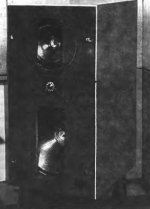Have a look at the following BBC document for the LS5/8 which uses a similar principle:
http://downloads.bbc.co.uk/rd/pubs/reports/1979-22.pdf
I cannot remember if it covers the design of the front panel cut-out for the bass unit.
http://downloads.bbc.co.uk/rd/pubs/reports/1979-22.pdf
I cannot remember if it covers the design of the front panel cut-out for the bass unit.
It can't be accurately decided by wave formulas alone. It takes experimentation and measurements for individual transducers. There are many things to balance. One is the off axis behavior of each 6.5'', since the dispersion is dependable on its cone flex and phase plug or dust cup. Then, the cavity behind the slot interacts with the cone shape and movement. The material and thickness of the slot baffle contributes also. Crossover frequency and slope is essential too. The goal is to get better off axis integration and certain desired dispersion without extra cavity and mechanical resonances coloring the area. In pro speakers that many such tricks are used, much wood is cut and many measurements are taken. Subjective evaluation and trial on error, is the order of the day despite the theory. I would try your 130mm starting point, it sounds logical.
LS3-5a
.. maybe this helps to find something more
http://home.wanadoo.nl/dezaire/LS3-5a/LS3-5a_clone.htm
Regards
Heinrich
.. maybe this helps to find something more
http://home.wanadoo.nl/dezaire/LS3-5a/LS3-5a_clone.htm
Regards
Heinrich
If I can see it accurately, the speaker in the photo is the BBC model that was described in detail in some 3 articles in 'Wireless World" in the 1960's. It was the March, April and May editions of 1968. Title:"New BBC Monitoring Loudspeaker". Author; Dudley HARWOOD. The cross-over frequencies were 400c/s and 3,500c/s. (12", 8" and Celestion dome. An extremely early, if not the very first use of Bextrene for the two cone drivers.) I think the Spendor BC3 was similar. As 'salas' said it is complicated. It is also worth bearing in mind an observation made by Martin Collums in his "High Performance Loudspeakers". In the section on mid-range speakers he notes that many prefer a 2" dome because they mistakenly think it must have better dispersion than a 6" cone driver because it is smaller. But he observes the actual radiating areas of the cone may contract to 1" diameter as frequencies rise where as a 2" dome will actually be worse if the 2" coil is dominating. As C.S.Lewis said: "Life is complicted and any description of reality that is not complicated is unlikely to be very useful".
Hi,
Being originally from the UK I was a great fan
of the Beeb and their amazing (for the time) outside
classical broadcasts. When I was growing up in the 50s my neigbour was a BBC engineer with an early Quad ELS and amp (Mono)
I had 16ohm LS3/5a from 1984 till I ran short of cash in 2002.
The active Ls5/8 with the "BBC slot" was always a great
speaker but a bit BIG! If anyone is planning a slot for their
dispersion woes take a look at the LS5/8 PDF page7 of 11 as it shows the slot is not square. I wondered why the later LS5/8 gave up the slot The later Kef made Ls5/1 had a slot but I have never heard one.
There was also some LS5/8 magic with the crossover and the BBC 2.8k? dip!
The technology in the B&O 5's appears to be an attempt to "widely disperse" sound in the midrange using a dome mid and very complex wave guides. If you can get it right a slot is a good cheaper solution!
Regards
AnthonyPT
The LS5/8 was first to use Polypropolene while the LS3/5a went the Bextrene Kef route with all the doping of the cone issues. My l3/5a went green in the Los Angeles smog for 8 years!
Being originally from the UK I was a great fan
of the Beeb and their amazing (for the time) outside
classical broadcasts. When I was growing up in the 50s my neigbour was a BBC engineer with an early Quad ELS and amp (Mono)
I had 16ohm LS3/5a from 1984 till I ran short of cash in 2002.
The active Ls5/8 with the "BBC slot" was always a great
speaker but a bit BIG! If anyone is planning a slot for their
dispersion woes take a look at the LS5/8 PDF page7 of 11 as it shows the slot is not square. I wondered why the later LS5/8 gave up the slot The later Kef made Ls5/1 had a slot but I have never heard one.
There was also some LS5/8 magic with the crossover and the BBC 2.8k? dip!
The technology in the B&O 5's appears to be an attempt to "widely disperse" sound in the midrange using a dome mid and very complex wave guides. If you can get it right a slot is a good cheaper solution!
Regards
AnthonyPT
The LS5/8 was first to use Polypropolene while the LS3/5a went the Bextrene Kef route with all the doping of the cone issues. My l3/5a went green in the Los Angeles smog for 8 years!
- Status
- This old topic is closed. If you want to reopen this topic, contact a moderator using the "Report Post" button.
- Home
- Loudspeakers
- Multi-Way
- BBC LS S/5 loudspeaker
